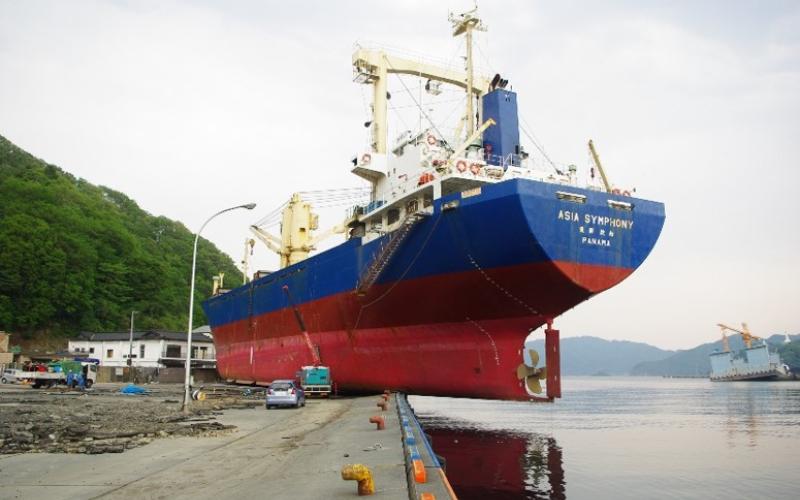3.11. Special Article - Kamaishi City, Iwate Prefecture
An interview from Kamaishi City
1. Eleven years have passed since the Great East Japan Earthquake. Can you tell us frankly about your current state of mind?
After the 2011 disaster, the city was in a terrible state. We received support from all around the world which we are extremely grateful for. As a result, we are finally able to see signs of recovery. Saying that though, for all those who were affected by the disaster and for their families, even though 11 years have passed, still hold sadness and grief in their hearts. In other words, everyone’s heart heals at a different pace and for this, I believe there is no time limit. We want to continue to provide support so that everyone can reach a place where they feel happy again.
2. What changes have taken place over the past 11 years, particularly in terms of industry and business in Kamaishi?
Of the 2,396 businesses that were in operation before the 2011 disaster, 1,382 (57.7%) were in the tsunami inundation zone and were forced to close or abandon their businesses following the disaster. However, many also rebuilt and were sent on a new trajectory by coming up with new business ventures. As a whole, the level of production has returned to pre-disaster levels.
The most problematic industry to this date is the fishing industry. The main types of fish have decreased in number, salmon, sanma (Pacific saury) and surume (squid). We originally thought this was an aftereffect of the tsunami but now that 11 years have passed, we now know that it is because of changes in the ocean current and global warming. This remains a big issue.
An area of growth is the activity of the international port in Kamaishi. Following the disaster, the port was equipped with a gantry crane, which remains the only one in all of Iwate Prefecture, and now handles the transhipping of cargo containers from around the world. The port activities are an important part of the economy in Kamaishi as well as Iwate Prefecture.
3. In 2019, Japan hosted the Rugby World Cup and in 2021 the Tokyo Olympics. How have these events affected Kamaishi City?
Kamaishi is known as the home to the former rugby team Nippon Steel who won seven national championships in a row back in the 80s. As a result, it is renowned as a rugby town all over Japan. The hosting of the Rugby World Cup in 2019 brought a lot of energy and enthusiasm to the city that had previously been lost to the 2011 disaster. The people of Kamaishi were revitalised with the will to continue forward. In addition, we were able to convey our fighting spirit and resilience to the prefecture and the whole country. For this, we are proud of our achievement and our city. With the COVID-19 pandemic happening only a few months after, we feel fortunate that the Rugby World Cup could go ahead as planned. Although the Tokyo Olympics was affected and not as much exchange with our host country Australia could occur as expected, considering the situation, we feel that overall it was a success. We also feel grateful for all the international exchange our city has been involved in through these two big events. We also recognise the importance of integrating SDGs in our projects and being one with the world. In this way, we believe that our citizens, especially the youth, have gained a global perspective and a broader horizon.
4. What are some of your ongoing 3.11-related initiatives?
One of our initiatives from the disaster is to continue to convey the lessons that were learned regarding natural disasters and protecting your life. We hope this will help to prevent future tragedy and loss of life in the event of a natural disaster. We do this through community building, disaster education in schools and regular evacuation drills. We also have a citizen’s charter which is an official declaration of what actions to take in times of disasters (English translation and link to Japanese is below). We particularly emphasise the importance of disaster education for the youth which has been ongoing since before 2011 and was of huge benefit to the students during the tsunami as they all knew how to evacuate properly and save their lives. We also wish to instil a culture of disaster awareness (災害文化) in our citizens. No one knows when a disaster will strike so the goal of this is to have disaster awareness become a natural part of our daily lives and our daily habits. One example is every year, we hold an event called the Idaten Race (韋駄天競走) where the goal is to run uphill to a tsunami evacuation center on higher ground. The event draws many participants and creates disaster awareness in an enjoyable way.
5. Eleven years have passed, and the children who were affected by the disaster are beginning to grow up. What kind of town do you want to build with the people of Kamaishi in the future?
From the 2011 disaster, the younger generation in particular has learned the importance of life and to value and appreciate what they might consider mundane life. This is something that the state of chaos during a disaster shows you firsthand. We wish to not forget what we have learned from our experience with natural disasters and to use these learnings to create a city that people can live safely and be proud of. How do we intend to do this? We try to make sure that everyone is aware of their own individual evacuation routes, how and when to evacuate, that people have connections with their neighbours, and have people become more involved in the community and the development of the city as a whole.

